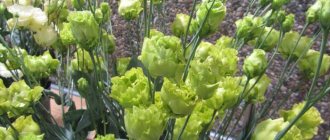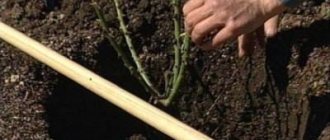Author of the article: Svetlana Golitsina | Updated: 12/21/2021
Polo Regatta
1129 ₽ More details
Polo Regatta
1129 ₽ More details
Regatta jackets
Flowers of other shades are gradually replacing traditional red and maroon roses. Thus, green roses, which will be discussed in our article, are becoming increasingly popular among landscape designers and florists.
History and description
Green roses were bred by the Dutch botanist Mayer. The specialist conducted numerous experiments. In 1782, he grafted a white rose onto a blackthorn shoot. The result was the appearance of a crop with green petals.
The height of the bushes depends on the variety. The shoots are powerful and have thorns. Inflorescences are small, large, medium. The color of the petals varies from a soft light green palette to a dark green color. They can be simple or terry. The buds are formed solitary or in clusters of inflorescences.
Boarding order
Spring primroses: names, photos and descriptions (catalog)
Proper planting of a green rose guarantees almost one hundred percent survival rate and further healthy development. The purchased seedling should be planted in prepared and well-warmed soil. Therefore, it is best to transplant roses, especially green ones, in the spring.
Proper planting of a plant consists of observing the following rules:
- When transplanting rose bushes, the soil temperature should be +19...+21 degrees Celsius.
- Avoid the appearance of late spring frosts.
- For southern regions, planting is best done in the fall, since hot summers can destroy the young plant. But before the onset of the first frost, the green rose must be covered with heat-insulating material.
- The flower should be transplanted into larger containers than those in which the seedling was grown. Such a container must have drainage holes.
- Prepare fertile soil composition. This can be done in several ways:
- mix nitrogen, phosphorus and potassium fertilizers one to one. All these ingredients can be purchased at specialized gardening stores;
- combine compost and rotted manure. The result is a very nutritious mixture for the plant;
- choose a well-lit place that will receive sunlight most of the day;
- After all the preparatory work, dig planting holes in the selected area. Their sizes should be larger than the containers in which green roses will grow;
- Lower the containers into the holes, and then place the bushes in them along with the soil. At this stage, you need to make sure that the soil is not disconnected from the root system, otherwise it may become deformed.
At the end of planting, the soil should be slightly compacted, watered abundantly and mulched.
Popular varieties of green roses
Breeders have bred many roses with green petals. The most popular varieties are:
Green Ice
The bushes of the crop reach a height of 40-50 centimeters. Gardeners use low-growing plants as borders. The buds initially have a pink-green color. The petals are shaggy and twisted. At the stage of complete dissolution, the buds acquire a white-green color. In comfortable conditions, the rose blooms three times per season.
Greensleeves
The height of the bushes of this variety varies between 75-85 centimeters. The leaves are dark green, glossy. The buds at the formation stage are light pink in color. Gradually the petals acquire an emerald color. The advantage of the variety is its good resistance to black spot.
Green Tea
The height of the bush is about 90 centimeters. The shape of unopened buds is a glass. Each of them contains 25-30 petals with wavy edges. At the dissolution stage, the bud takes the shape of a deep bowl. The petals are colored light green.
Super Green
The rose of this variety is not tall. Its beauty lies in its double buds. Each flower consists of 50-130 petals. The edges of the buds are painted in a light green palette.
The middle of the flower takes on a rich color. Florists love to use Super Green for bouquets.
Limbo
The bushes of the variety are compact: the height does not exceed 80 centimeters. The leaves are large and glossy. The resulting buds are cone-shaped. When fully bloomed, the flower takes on the appearance of a bowl. The petals are painted with a yellow-green palette.
See also
When is it better to transplant roses to another place, rules and timing of the procedureRead
Wimbeldon
The bushes, about 1 meter high, have sparse thorns. Petals are yellow-green, wavy. The unusual thing about this variety is that there is a red stripe along the edges of the buds. The flower is loved by florists: they create beautiful compositions from the plant.
Lime Sublime
The rose variety was bred by Irish specialists. The bushes bloom profusely and for a long time. The first buds appear in late spring. Flowering lasts with a short break until the beginning of autumn. The petals are painted with a soft green palette. Lime tolerates the scorching sun well.
St. Patrick's Day
This rose variety is intended for cultivation in the southern regions, as it does not tolerate cold weather. The bud of the hybrid has a goblet shape. At the dissolution stage, the inflorescence becomes cup-shaped and reaches 12 centimeters in diameter. The petals are painted with a golden-green palette.
Gloria Dei
The main color of Gloria Day's buds is pink-yellow. The petals of the variety have only small inclusions of green color. The diameter of the inflorescences is 13-15 centimeters. The bud contains 45-50 petals. Gloria Day is the progenitor of many rose hybrids.
Application in landscape design
When planting a plant in a flowerbed, consider not only the combination of colors, but also compatibility with other flowers. You cannot plant roses and dahlias and gladioli in the same flower bed - they will oppress each other. Green buds harmonize well with violas, low-growing carnations, and lilies. If several varieties of roses are grown in a flowerbed, sage, lavender, and oregano will help fill the space between them.
On a note! Rose can be combined with conifers, lilacs, and sea buckthorn.
The planting location is determined depending on the varietal characteristics of the plant - tall flowers are planted solitary, low-growing ones are used in decorating rockeries and alpine slides. Climbing species are planted along fences and gazebos, along walls. On supports, roses look good as single plants. Ground cover varieties complement well a flower bed located on a slope.
To ensure flowering throughout the season, several roses are planted with different growing seasons. By alternating colors and types, you can get a bright flower bed or decorate a border. Plants are in demand among photographers, decorators, and when decorating festive events.
Specifics of cultivation and care
The decorative effect of green roses depends on planting in the right place and on timely implementation of agrotechnical measures. Purchase seedlings from plant nurseries or garden centers. There should be no dents, stains or damaged parts on the bushes. 1-2 hours before planting, the plants are placed in water, to which potassium permanganate can be added for disinfection.
Landing
Roses are planted in the ground in spring or autumn. Choose a sunny place, protected from cold winds. The culture does not tolerate lowlands and wet areas. The substrate for plants is made up of garden soil, compost, peat, sand. The hole is dug 2 weeks before planting the bushes in open ground.
Planting a green rose is done as follows:
- dig a hole 50 centimeters deep and wide;
- 10-15 centimeters are filled with drainage made of fine crushed stone, expanded clay;
- pour the fertile layer mixed with a small amount of mineral fertilizers;
- pour out the rest of the substrate in a heap;
- Place a bush in the middle, straighten the roots;
- covered with substrate.
The bush is watered abundantly and mulched.
Specifics of care
Caring for roses involves watering, fertilizing, loosening the soil, and mulching. Faded buds are cut off. This is necessary for the formation of new inflorescences, as well as for maintaining the decorative appearance of the bushes. To prevent the occurrence of diseases, plants are sprayed with fungicides in the spring.
See also
Rules for planting, growing and caring for climbing roses in open groundRead
Watering
The tree trunk circle is irrigated after the top layer of soil has dried. Excess moisture can lead to the appearance of putrefactive microorganisms. Water the rose in the morning or evening with warm, settled water. At least 1 bucket of water is poured under the bush.
Loosening and mulching
A few days after watering, the soil around the bushes is loosened. The procedure promotes air access to the root system. Weeding removes weeds that carry diseases and pests. To preserve moisture, the tree trunk circle is sprinkled with mulch consisting of sawdust, straw, and peat.
Top dressing
For rapid growth of shoots, abundant and long flowering, green roses are fed several times a season. In the spring, nitrogen is used, in the summer - mineral fertilizers with an advantage in the composition of potassium and phosphorus. In the fall, potassium is added, which contributes to the successful wintering of the bushes.
Trimming
Dry, broken, diseased stems are cut off throughout the season. Remove shoots growing inward. The buds that begin to dry out with parts of the branches are cut off. After this, the bushes not only look more decorative, but also begin to grow young shoots from the lateral buds.
Landing
Gardener's Encyclopedia: 16 of the most beautiful varieties of peony roses with photos
Growing this unique but finicky flower will require a lot of work, knowledge and skills. First of all, the quality of seedlings plays an important role, so it is advisable to purchase them from nurseries and not subject them to long transportation and storage. This will negatively affect the survival rate of rose bushes. It is recommended to choose seedlings of zoned varieties, otherwise the heat-loving plant will die. Preference should be given to seedlings with strong and living roots, without signs of disease, damage, or decay.
For good growth of green roses, loose, slightly acidic fertile soil is recommended. Sand should be added to clay soil, and garden soil and organic matter should be added to sandy soil in equal quantities. Humus (humus) and compost must be added to any type of soil in advance. It is also useful to add superphosphate, nitrophoska, ash or complex fertilizers. In the central regions of our country, the best time for planting is spring and early autumn. This is most often the second half of April and until the end of May
An important condition must be observed - the earth must be warmed up to at least +12 degrees and the weather must be warm. For the southern regions, spring planting is not recommended, since the summer heat has a detrimental effect on young bushes
In autumn, roses are planted from mid-September until the first days of October. Such planting dates ensure that the bushes take root and take root before frost, and buds on the stems will not develop. Before the onset of cold weather, young rose seedlings need to be insulated with some kind of covering material. Proper planting plays an important role in the subsequent development of a green rose.
Rules for planting plants.
- In advance (one or two weeks in advance), dig a hole of such a size that the roots of the seedling can freely fit in it. Typically its size is 0.6x0.6m with a depth of 0.7m. The top most fertile layer of soil must be carefully removed.
- Drainage made of crushed stone, gravel or any pebbles is laid on the bottom.
- Then the drainage is covered with a small layer of soil mixture with complex fertilizers. The following composition is possible: dolomite flour (2 cups), superphosphate (2 handfuls), ground clay, peat (a bucket each), garden soil and bone meal (2 buckets each). This composition fills the hole to 0.4 m.
- Water the hole with plenty of water.
- Dip the roots into it and carefully straighten them, and then cover them with the top layer of removed soil and compact the soil.
There is a more complex method of planting a green rose: preliminary planting in a container. It is selected taking into account the size of the seedling's roots and must have holes. It is filled with soil mixture. Further planting is done as follows: the container is placed in a previously prepared hole, covered with soil and watered well.
Diseases and pests
The appearance of diseases and pests on roses is facilitated by: unfavorable weather conditions, dense plantings, damage, and poor care. The presence of weeds increases the risk of attacks on plants by pathogenic microorganisms and harmful insects. Green roses can be affected by powdery mildew. The disease is favored by a humid environment. It is manifested by the presence of a powdery coating on the leaves and shoots. Another common crop disease is rust. The fungus causes yellow-orange bumps to form on the leaves.
The main pest of roses is aphids. It densely adheres to the shoot with the bud rudiment and drinks the cell sap. Another pest, the spider mite, is found on the underside of the leaves. Under unfavorable influence they turn yellow and fall off.
Note! To prevent the appearance of diseases and pests, bushes are treated with special preparations several times a season.
What it is?
Speaking about park roses, it is immediately worth noting that there are several subgroups of such plants.
There are three in total:
cultivated rosehip species;
The park rose blooms early, and this process lasts up to a month, and in some varieties longer. The colors of the buds are very multifaceted: you can see both soft white flowers and specimens of deep purple color. To the touch, the bud is a little rough, terry, and the number of petals exceeds 100 pieces - no other variety of roses can boast of this.
Park roses can also be divided into two large groups:
- bloom once;
- blooming repeatedly.
The first variety most often grows in private plots, where the gardener has the opportunity to renew the plant annually. However, here you need to take into account an important nuance: you cannot cut off last year’s shoots: this will lead to flowering simply not happening. But such roses are incredibly frost-resistant; some varieties can easily spend the winter without additional shelter. Roses that bloom repeatedly do not always have the advantage of cold resistance. Here, too, there are excellent varieties that can survive the winter without any problems, but there are also those that require not only shelter, but also bending of the branches.
Let's consider the advantages of all park roses:
long and beautiful flowering;
There are several disadvantages that also need to be taken into account:
some varieties do not tolerate winter well if they are not prepared;
Combination with other plants
When creating a rose garden, experts in the field of floriculture recommend paying attention not only to the attractiveness and compatibility of the flower arrangement, but also to the botanical features of the crops grown together:
- roses cannot be grown in the same space as gladioli and dahlias, since these ornamental crops can have a depressing effect on each other;
- a classic addition to roses can be planting sage, bluebells, speedwell and foxglove;
- Almost any flowering annuals look very good with roses;
- a good “companion” for green-flowered roses is bulbous ryegrass;
- decorative and beautifully blooming throughout the season, heuchera, lobelia and cineraria do not overwhelm roses and serve as a worthy frame for the “queen” of flowers;
- you can fill the space between rose bushes with plantings of thyme, oregano, hyssop, lavender, sage, lofanta, loosestrife, yarrow Ptarmika, phalaris and hakonechloa.
Trimming
Creeping roses should not be radically pruned. Although in the first year the stems are shortened in order to cause tillering. It is necessary to form a bush to constantly limit the size, which is considered optimal for the variety. To prevent the occurrence of mold or fungal diseases, you need to ensure that the bush is ventilated and is sufficiently illuminated by sunlight.
Important! The shoots are cut at an angle of 45°, the distance of the cut from the nearest bud should not be less than 0.5 cm. They prune mainly those branches that are directed towards the middle of the bush and thereby thicken it greatly. If several shoots grow from one bud, leave the strongest one, the rest are removed
5–6 years after planting, ground cover roses should be rejuvenated. Cut off all stems at a distance of 20–30 cm from the root. All cuts must be treated with garden varnish, the bush is sprayed with a one percent solution of copper sulfate
If several shoots grow from one bud, the strongest one is left, the rest are removed. 5–6 years after planting, ground cover roses should be rejuvenated. Cut off all stems at a distance of 20–30 cm from the root. All cuts must be treated with garden varnish; the bush is sprayed with a one percent solution of copper sulfate.
No matter how beautiful ground cover roses are, caring for and growing most of them is not a very labor-intensive process, which is why this variety of flowers has become popular recently. They are in high demand and look very impressive in various flowerpots and flower beds. In addition, they often decorate nondescript areas.
Creeping roses are versatile and can be grown and tied like climbing roses. Planting such plants in the center of even the best grass lawn will give it much more originality. Small ground cover roses can be bred in wide containers and placed on the site in the summer, and brought into the house in the winter, turning it into a house plant for the winter.
vote
Article Rating











